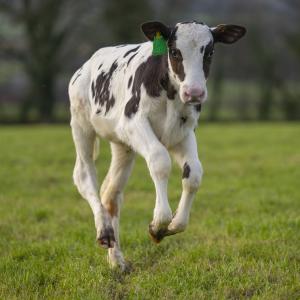
by vet Rob Simmons

There’s been quite a bit of media coverage of the birth of Hilda the calf recently, and not all of it has been accurate.
Hilda is the first calf born from the CoolCows project. As Paragon is one of the partners behind this initiative along with Semex and Scotland’s Rural College SRUC, we understand the truth behind the headlines.
Here, then, is the background to Hilda.
Firstly, the project came about through a discussion between me and several SRUC professors following news that Semex had discovered a genomic test for methane efficiency.
Methane is produced from all ruminant animals as part of their normal process of digesting grass and forage. Microbes within the rumen carry out digestion and release methane as a by-product, but there are differences between what bugs are in each animal’s guts, and as a result some animals produce less methane than others.
The numbers and type of microbes in the rumen are, in part, influenced by the animals’ DNA. Having discovered a way to identify which animals will produce less methane there is an opportunity to breed offspring from these animals, rather than their higher methane-producing herd mates, as a potential tool to reduce the methane production of UK agriculture without compromising food production, quality and welfare.
Farmers get a lot of blame for climate change, but this is significantly overstated due to the measurements used, especially in the UK where farming systems differ from less eco-friendly practices overseas. Whilst methane is a potent greenhouse gas, it is very short-lived in the atmosphere when compared to carbon dioxide. This time aspect is often overlooked, which means methane, and therefore farming, is ‘scored’ more harshly than CO2 emitting industries.
The short life of methane means that any reduction can rapidly contribute to the slowing of climate change, and global cooling, much more quickly than CO2 reductions.
In reality farmers have been improving their methane efficiency ever since selective breeding began. Breeding for better production, reduced disease, greater longevity etc all reduces the methane emitted per unit of milk or meat produced; breeding specifically for this trait is merely another tool available to the industry.
So, the aim of the project is to understand the impact that breeding can have on methane emissions. To be clear, there is no genetic modification or editing involved in the work being done. The team has identified the most methane-efficient females from the Langhill herd in Scotland, and bred them to the most methane-efficient bulls worldwide that we could receive semen from, using IVF.
The reason for using IVF is that it allows more calves to be born from the best animals in a shorter timeframe. Instead of the best animal producing one calf per year, she can produce a number of embryos which are put into surrogate cows, and produce say, 5 or 6 calves per year. Because she has more calves, there is more chance that one or more will be better than she is, and that one of them will be better than the single calf she would have had normally.
Hilda was born in November, and there have been a couple more calves born in December as part of the project, with more on their way.
We will be measuring their methane production, to see what impact selective breeding for methane efficiency has.
Is Hilda going to save the world? The short answer is no. But hopefully she signals another way the farming industry is continuing to do its bit to fight climate change.
And she shows that we are part of the solution, rather than the problem, whilst we wait for reductions in CO2-emitting industries to have an impact in several generations’ time.